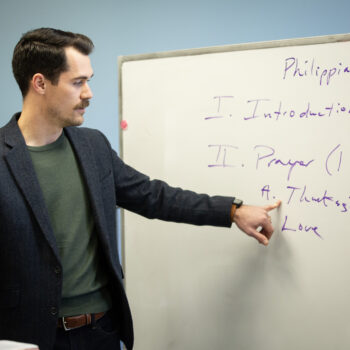Academic Standards
Accommodations should not lessen course requirements or reduce academic standards. Instead, accommodations may slightly alter an instructor’s teaching style or testing methods since they are tailored to reduce or circumvent the limitations imposed by the disability of a student. If an instructor is concerned that any of the accommodations may alter the course requirements or otherwise compromise the integrity of the course, the instructor may discuss alternative solutions with the Director of Student Accessibility Services. A conversation with the student will occur as needed after concerns are resolved.
Contact
Email: accessibility@mobap.edu
Phone: (314) 744-5312
Resources for Faculty
Accommodations should not lessen course requirements or reduce academic standards. Instead, accommodations may slightly alter an instructor’s teaching style or testing methods since they are tailored to reduce or circumvent the limitations imposed by the disability of a student. If an instructor is concerned that any of the accommodations may alter the course requirements or otherwise compromise the integrity of the course, the instructor may discuss alternative solutions with the Director of Student Accessibility Services. A conversation with the student will occur as needed after concerns are resolved.
Teaching Students with Learning Disabilities
- Start each lecture with an outline of the material to be covered in that class.
- Provide study questions for exams that demonstrate the format.
- Explain what constitutes a good answer and why.
- Allow students to break exams into shorter segments.
- Make the course syllabus available before the start of class, including a list of texts to use.
- Make the course requirements and due dates for assignments very explicit.
- Students with learning disabilities often learn best from hands-on projects, videos/films, overhead transparencies, and role modeling
Teaching students with hearing impairments
- Discuss with the student the requirements of the course and determine if there are ways that the materials can be modified so that the student can participate.
- Communicate important messages by writing them down instead of only saying them
- Determine a seating arrangement with the student before class time. This allows the student to sit where he/she feels it would be most beneficial.
- Always speak directly t other students and not to his/her interpreter. Try to speak slowly and clearly
- Try not to turn your face away while you are speaking as the student may depend on lip-reading to supplement what they miss orally.
- Make sure you have the student’s attention before speaking
Teaching Students with Speech Impairments
- Discuss with the student ways to help in the classroom and ask of their specific needs
- Be patient while they are speaking with you
- Realize that the student speaks slower and may need more time to express themselves without interruption or unsolicited aid in filling in gaps in their speech.
- Ask the student to repeat words or phrases when you do not understand them
- After the student is finished speaking, summarizing the message is often a helpful way to check that you correctly understood the message.
Teaching Students with Visual Impairments:
- Orally say everything you are writing down
- If using white dry-erase board, use black markers
- If using green board, use yellow chalk
- When showing things in an overhead, explain orally
- Enlarge font and bold type on tests and handouts
- Face the class when speaking, not the overhead or chalkboard
Teaching Students with Mobility and Dexterity Impairments:
- Lateness may be unavoidable: inclement weather, crowded walkways, and hallways, waiting for elevators, and wheelchair breakdown are a few examples of challenges.
- If you have field trips, plan accommodations to ensure accessibility for the student Discuss with the student if there are methods that can help in the classroom.
Teaching Students with ADD/ADHD
- Give assignments both orally and in writing
- Allow students to take a break during long lecture periods
- Speak directly to the student and use gestures and natural expressions to convey meaning
- Allow student to break exams into shorter segments
- Consider giving frequent quizzes versus long tests
- Discuss with the student before class time if there are methods that can help in the classroom Provide outlines or study guides for lectures
Teaching Students with a Psychological Impairment
- Discuss with the student ways that you can help in the classroom
- Encourage the student to disclose any functional limitations
- Provide honest feedback when behavior is inappropriate and talk about alternative behaviors
- Allow breaks during instruction


